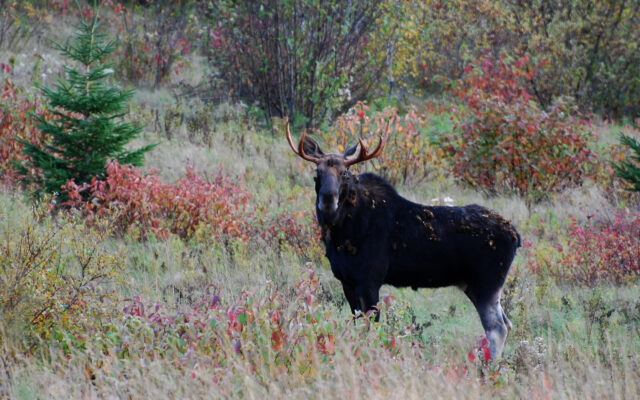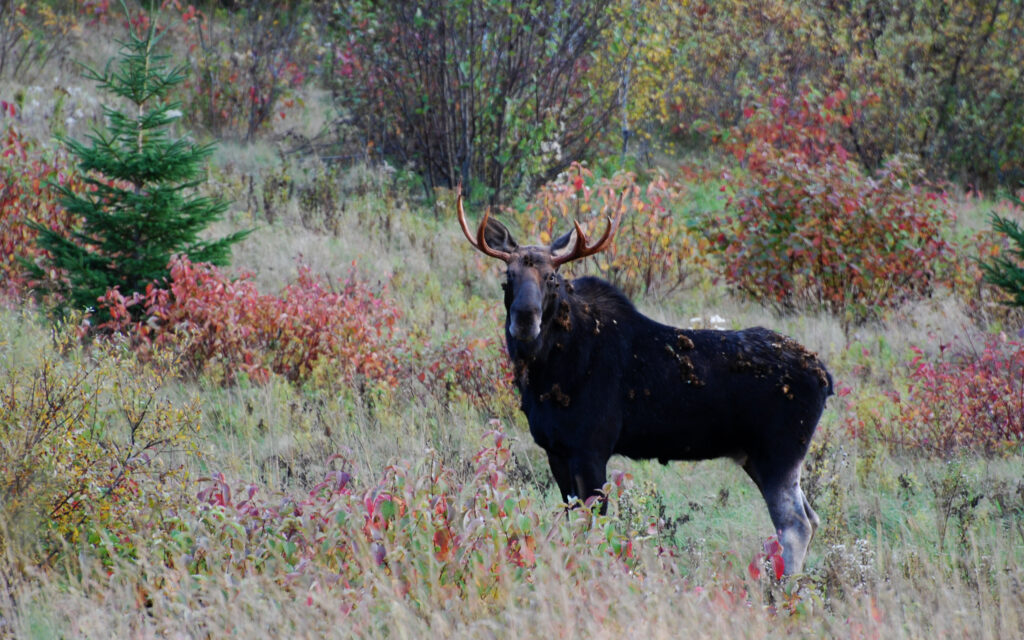
What’s the most lethal spot to shoot a moose?
By V. Paul Reynolds
A Maine moose, because of its sheer size, demands precise shot placement. Moose biologist Lee Kantar says placement is crucial, but it’s only one part of a humane kill. The right bullet type, an appropriate caliber and practiced marksmanship are equally essential.
So what is the most lethal shot on an 800-900-pound moose? I asked several highly experienced guides and hunters.
In his book “Moose Hunting,” noted guide and author Dave Kelso writes that the best possible shot is in the neck, a comparatively large target.
“Within the neck you have major arteries and the spine, so even if you miss the spine, you will likely cause severe arterial damage,” he writes, noting that such a hit usually puts the animal down and allows for a follow-up shot.

BULL MOOSE — This fine bull moose is covered with burdocks after plowing through the woods and brush to investigate cow calls. During hunts, using a moose call is very productive.
Kelso’s view runs counter to conventional big-game wisdom, where hunters typically aim for the vitals — the heart and lungs. Not surprisingly, seven of the nine experts we polled favored a heart-and-lungs shot. Two said a neck shot could be appropriate if the moose was within about 100 yards.
Kantar stresses the importance of ranging the animal before shooting. “Too many moose hunters rely on the 1-2-3 shoot with two guns blazing,” he said. “The second shooter should be using binoculars to establish range, shot placement, impact and the direction the moose went after the shot.”
Guide Matt LaRoche agrees that a precisely placed neck shot can drop a moose immediately, but he warns of the risks if the shot is missed. He advises clients to aim for the heart and lungs. Experienced hunter Josh Cottrell, says, “I’m a fan of heart and lungs. Guaranteed kill if you put the bullet there. Moose are tough, but if you put the bullet or arrow where it belongs, they don’t go far.”
Outdoor video producer and guide John Altman prefers a heart-and-lungs shot but would take a neck shot if the moose were within range and it was the only option. Outfitter John Floyd favors a neck shot at 100 yards and under, but says that beyond that distance he would want to be confident in the shooter’s ability and would consider a traditional vitals shot safer.
Tom Kelly noted that many guides favor a low neck shot because it can drop a moose in its tracks when executed properly, but he personally prefers a double-lung shot for the greater margin of error.
Dave Hentosh of Smoldering Lake Outfitters, who has extensive moose-hunting experience, calls lung shots the “safest and most reliable.” He notes that the lungs provide an 18-inch impact zone, offering room for error while still ensuring a quick, ethical harvest. More shot-angle opportunities and a high lung shot can also shock the spine, and most lung-shot moose expire within 20 yards.
Hentosh emphasizes that shot placement alone isn’t enough. Hunters also need to choose their bullets carefully, opting for “controlled expansion” types such as Nosler Partitions, and local gun dealers can assist in matching the right ammunition to a firearm.
In short, most Maine experts favor a heart-and-lungs shot for its reliability and margin for error, while a neck shot is considered effective only at close range and in experienced hands. Regardless of placement, professional range estimation, appropriate ammunition and practiced marksmanship are nonnegotiable for an ethical kill.
The author is editor of the Northwoods Sporting Journal. He is also a Maine Guide and host of a weekly radio program “Maine Outdoors” heard Sundays at 7 p.m. on The Voice of Maine News-Talk Network. He has authored three books. Online purchase information is available at www.sportingjournal.com, Outdoor Books.